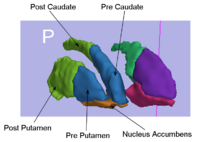DBP1:Irvine
Contents
Overview of UC Irvine Collaborations
This is where the overview of your Collaborations goes. Also, please replace these images with ones that correspond to your research
UC Irvice Projects
Rule Based SegmentationIn this work, we provide software to semi-automate the implementation of segmentation procedures based on expert neuroanatomist rules. We have implemented our code in Slicer 2. We currently provide modules for the semi-automatic segmentation of the DLPFC and the Striatum.More... New: | |
| File:Placeholder.png |
DTI ValidationTo carry out quantitative and qualitative validation of the DTI tractography tools. These will be applied to a limited set of specific tracts in single data sets and single tractography tools, and on several data sets using at least two tractography programs and by investigators in different laboratories More... New: |
| File:Placeholder.png |
Optimal Imaging Phenotypes In Schizophrenics and ControlsIn a legacy dataset of 28 chronic schizophrenics, to determine fMRI activation during working memory in schizophrenia and apply novel tools to assess circuitry between regions through combining behavior and BOLD signal analyses. More... New: |
| File:Placeholder.png |
Attentional Circuits In Schizophrenia In fMRI And PETTo use structural equation modeling to compare attentional circuitry within the legacy set of 28 schizophrenic subjects who performed similar attentional tasks in both a PET and fMRI scan.More... New: |
File:Placeholder.PNG 200px |
MultiSite MorphometryTo compare morphometric/volumetric differences in a multi-site anatomical sample of schizophrenic subjects, in collaboration with the FBIRN consortium. Subject morphometric scans will be sent to UCSD's morphometric processing lab (Dale) for automated processing. A system for submitting morphometric scans to processing pipeline and retreiving/wrapping the results for inclusion into FBIRN HIDs will be developed. The project will also be used to drive the development of the workflow processing system being developed by Shawn Murphey's group. More... New: |
